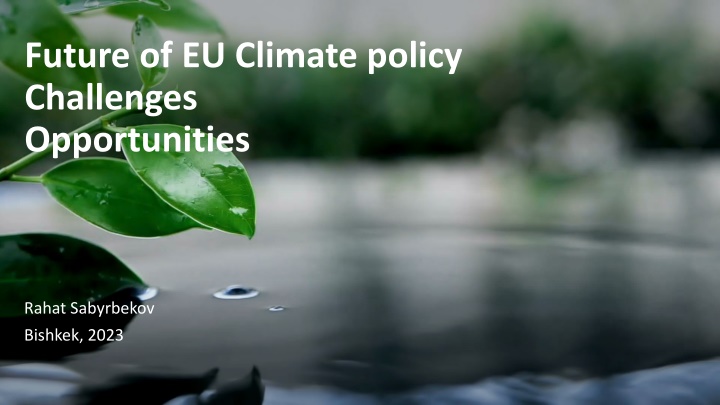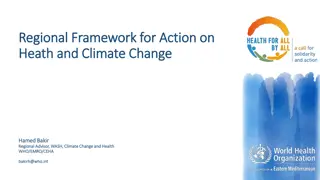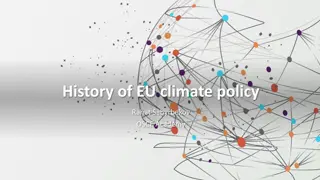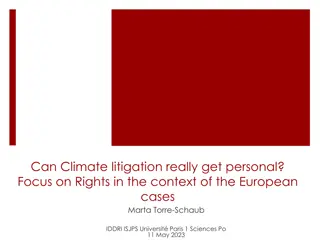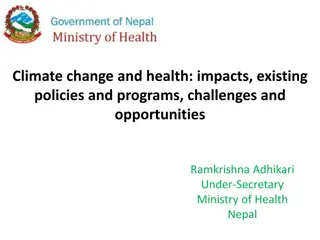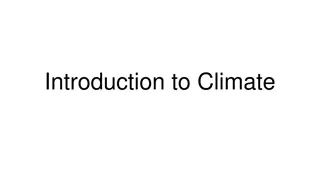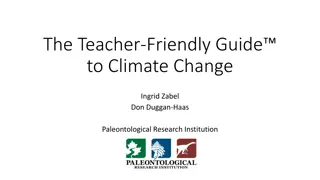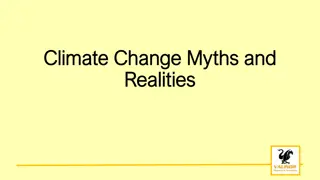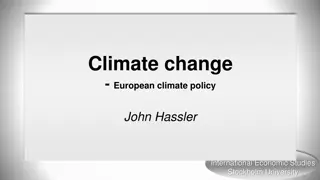The Evolution of EU Climate Policy: Challenges and Achievements
The EU has made significant strides in climate policy over the years, from meeting emission reduction targets to implementing domestic policies and pursuing international agreements. Challenges such as burden-sharing agreements and compliance have been addressed, with a focus on post-Kyoto climate policies. The EU's credibility as a global climate leader hinges on fulfilling its commitments and transitioning to a low-carbon economy.
Download Presentation

Please find below an Image/Link to download the presentation.
The content on the website is provided AS IS for your information and personal use only. It may not be sold, licensed, or shared on other websites without obtaining consent from the author.If you encounter any issues during the download, it is possible that the publisher has removed the file from their server.
You are allowed to download the files provided on this website for personal or commercial use, subject to the condition that they are used lawfully. All files are the property of their respective owners.
The content on the website is provided AS IS for your information and personal use only. It may not be sold, licensed, or shared on other websites without obtaining consent from the author.
E N D
Presentation Transcript
Future of EU Climate policy Challenges Opportunities Rahat Sabyrbekov Bishkek, 2023
Two Decades of European Climate Policy: A Critical Appraisal Christoph B hringer
Contributing Its Own Share of Emission Reductions EU s credibility as a leading force for climate policy depends on fulfilling its emission reduction obligations under the Kyoto Protocol by 2012 and post-Kyoto unilateral reduction commitments. EU committed to reduce its GHG emissions by 8 percent from 1990 levels during the 2008 to 2012 period. EU successfully met its reduction target through domestic policies, carbon sink activities, and credits for emission reductions achieved outside of the EU.
Burden-Sharing Agreement and Compliance A political agreement was reached in 1998 to divide the burden of meeting the aggregate EU target nonuniformly among EU member states. The EU s compliance is due to the collapse of emission-intensive industries in Eastern Europe and the recent global economic recession. Impact assessment found that only about half of the emission reductions in the EU since 1990 were triggered by environmental policies.
Post-Kyoto Climate Policy The EU announced an ambitious climate policy in March 2007, agreeing to unilaterally reduce GHG emissions by at least 20 percent in 2020 (relative to 1990 levels). The EU also includes additional targets for renewable energy and energy efficiency, where renewable energy will account for 20 percent of the EU s gross final energy consumption, and energy efficiency will be increased by 20 percent by 2020. These targets were put into legal force in December 2008 under the EU Climate Action and Renewable Energy Package to foster the EU s transition toward a low-carbon economy over the next decade.
EU Climate Policy - Meeting Fundamental Criteria Since early 1990s, climate protection has been high priority on EU policy agenda EU climate policy must meet three fundamental criteria: Pushing for international agreements on climate protection Making its own contribution to global climate protection Implementing domestic climate policy at least cost
EU Climate Policy Successes EU has consistently pursued a global climate treaty and assumed a leadership role Met its own emission reduction targets under the Kyoto Protocol in 2012 Committed to more ambitious and legally binding GHG emission reduction targets for 2020 and beyond
EU struggles with implementing unilateral emission abatement in cost-effective manner EU ETS covers only 45% of EU's GHG emissions, and remaining 55% requires complementary regulations at member state level Additional targets for renewable energy and energy efficiency under EU Climate Action and Renewable Energy Package create potential excess cost. Challenges for the EU Climate Policy
Conclusions EU has played a critical and constructive role in the battle against climate change In the future, EU needs to promote market-based emission regulation through a comprehensive EU ETS This could serve as the foundation for a global GHG emissions market.
A comprehensive socio- economic assessment of EU climate policy pathways,2023 Matthias Weitzel, Toon Vandyck, Luis Rey Los Santos, Marie Tamba, Umed Temursho, Krzysztof Wojtowicz,
Intrduction In 2019, the European Commission announced the European Green Deal with the target of achieving climate neutrality by 2050. To achieve this target, the Commission proposed to strengthen the existing emission reduction target for 2030 to reduce emissions by 55% relative to 1990 levels. The proposed adjustment was announced as the 2030 Climate Target Plan and was supported by a research-based impact assessment, which investigated the general consequences of increasing climate ambition in 2030 under different policy options. In this paper, the authors describe the methods and illustrate key results from their contribution to this assessment, which investigates the general consequences of increasing the climate ambition in 2030 under different policy options.
Modelling Toolbox and Policy Packages The authors developed alternative policy pathways that varied in their reliance on regulatory measures such as standards or carbon pricing to reach the targets. They focused on the socio-economic impacts by drawing on results from the computable general equilibrium (CGE) model JRC-GEM-E3. Key outputs of the CGE modelling are changes in variables that describe the macro economy, such as GDP and its components or aggregate employment, and changes in sectoral activity for the different policy packages. The authors assessed distributional implications and labour market consequences, which are of key concern to achieve a just transition .
Scenarios A number of scenarios reaching the 55% goal were assessed, making different behavioural, modelling and policy assumptions. The key policy assumption determines the mix of carbon pricing policies (e.g., carbon pricing in the EU ETS) and regulatory measures (e.g. vehicle emission standards or policies to increase building renovation rates) to reach the targets. Important behavioural assumptions include how producers respond to free allowances
Results The overall effect on the macro-economy indicates relatively minor costs, in the range 0.23 to 0.42% of GDP, depending on the scenario assumptions For aggregate consumption, there is a wider spread across the scenarios. The impacts of the 55% reduction target are felt most in the energy sectors For the non-energy sectors, changes in output are determined by the carbon intensity of the sector in combination with the exact policy package, in particular the inclusion into the EU ETS
Implications and Conclusions The economic implications of the different policies packages depend on the exact design and may have important differences for different income groups. While the aggregate GDP impacts of the different policies are fairly similar, a deeper dive into the disaggregated outcomes reveals that the design of the policies can determine changes in sectoral output and hence for labour markets. Carbon pricing and regulatory measures differ in their impacts on (consumer) prices and hence distributional impacts, but revenue recycling can mitigate some adverse effects. The authors' findings aim to contribute to an open and research-based dialogue on climate policy design and create a real-world application of a policy package in the context of EU climate policy, where a combination of policies has been in use for several decades.
The Evolution of EU Climate and Energy Policy over the last 30 years https://www.youtube.com/watch?v=oOHUPjv91vE
Thank you! Questions? r.sabyrbekov@osce-academy.net
